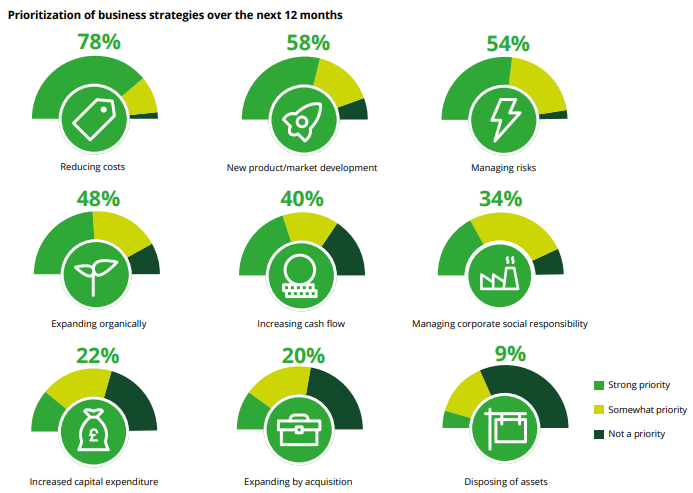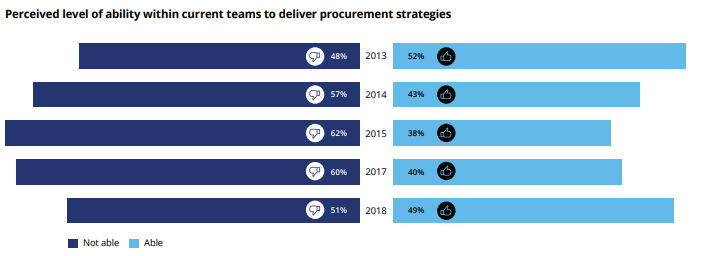The procurement process is often not an easy one to handle, with several moving parts to consider. However, having a strategic procurement process in place will equip your organization with one of the most important tools to maximizing its value and priorities.
A strategic plan is one that is created with the aim of achieving long-term goals rather than short-term solutions. It can shape the way in which your organization operates for a sustained period of time. Therefore, given the complexities involved, strategic procurement requires the involvement of an entire organization.
In many ways, the most important working relationship in an organization is that of the CPO and CFO. Many of their priorities and financial responsibilities overlap and if both Finance and Procurement are to be successful in achieving their goals, strong collaboration between both must exist.
According to The Deloitte Global Chief Procurement Officer Survey 2018, the likes of cost control, risk management and technological advancements are some of the key issues being treated as priorities by both CFOs and CPOs. With global inflation pressures easing in most regions, CFOs are adopting a strategic approach and shifting their focus towards the longer term as revenue growth improves. Such common priorities highlight an opportunity for CPOs and CFOs to work together to align organizational and procurement strategies.
Ways to Fuel Strategic Procurement
1. Include Procurement in Strategy Process
For strategic procurement to truly work, it is vitally important that procurement teams are involved in the early stages of overall strategy planning for the organization. Everyone needs to be fully aware of what their roles are, what the goals of the business are and what is defined as valuable. From there, procurement teams can then work on aligning their KPIs.
CPOs should work with CFOs to develop a balanced procurement performance scorecard, with sensible targets for the team agreed upon. CPOs are in a strong position to influence and control suppliers while also providing strategic insights to the CFO around the types and capabilities of available suppliers. This takes procurement away from the traditional savings-related metrics and focuses attentions on total cost, performance and innovation.
2. Optimize Working Capital
Given that procurement teams work directly with suppliers, they are in a strong position to influence their organization’s strategic procurement process through the management of working capital. By managing stock levels and negotiating advantageous payment terms with suppliers, procurement teams can enable the CFO and treasury to accurately forecast cash flow.
Positive cash flow puts you in a more stable position with better buying power and opportunities for growth. Supplier relationships are also enhanced as a result. In a recent blog, we outlined some of the most important tips for effectively managing working capital.
3. Utilize Technology to Reduce Costs
Establishing cost saving opportunities has always been a fundamental part of procurement and amongst the top priorities for businesses. The Deloitte Global Chief Procurement Officer Survey 2018 found that this is very much still the case.

CFOs and CPOs now have access to a wide range of innovative technologies and advanced analytics systems to support their cost-saving efforts. It is important that CFOs are supportive of investment in technologies that procurement teams need in order to implement a strategic procurement process. Technologies can be leveraged to better monitor performance, ensure contract compliance and analyze supplier activities. E-procurement systems can continually scan data and alert to opportunities for savings such as better rates offered by different suppliers and reduction in maverick spending.
While technology investment will greatly improve a CPOs ability to carry out their procurement process in a strategic manner, CFOs will also leverage the power of spend analytics. The data produced through this analysis will influence cash flow management, product or market development and expansion for the overall business.
4. Talent Development
Technology and data are key to establishing a strategic procurement process, but CFOs and CPOs need to work together to ensure that they invest in the correct talent and training with which to capitalize on such assets.
The skill set required to work in a modern procurement team is constantly evolving. For example, more so than ever before procurement professionals require strong data management and analytical skills. These skills fuel smarter spending, supplier relationships and risk reduction. Strategic procurement is now more so about data-based decision making rather than simply squeezing cost savings out of suppliers.
However, talent development is very much an issue for CFOs and CPOs when it comes to developing their procurement strategy. The Deloitte report found that only 49 per cent of CPOs believe that their current procurement teams have the required levels of skills to successfully deliver on their organization’s procurement strategy. This percentage has improved in recent years but is still remarkably low.

It is critical that procurement teams establish a strong working relationship with the CFO. If talent development in certain areas of procurement continues to be an issue, then outsourcing should be considered. Such a move will allow the internal procurement team to focus their attentions on using their company knowledge and strategic depth in different areas of the business. The external party could play a more specialist role in their dedicated area establishing the ideal blend of expertise and skills internally while also opening up the organization to the outside world.
5. Open Communication
None of the previous points are likely to come to fruition, however, unless there is an open line of communication between the CFO and CPO from the outset of establishing a strategic procurement strategy. The CFO needs to be fully behind the work of the CPO.
Business financials need to be regularly communicated to the CPO and procurement function so that conversations can be had over procurement’s role in driving the business forward.
It is also important for CFOs to understand all areas of the business, particularly procurement. They need to be made aware of any potential roadblocks for the procurement function or any potential issues, ideally in advance of them occurring. Having such knowledge will allow the CFO to establish which area requires the highest levels of support and investment.
Conclusion
As we established at the beginning of this blog, CFOs and CPOs share many priorities and responsibilities that present opportunities for them to work together. While the CPO will have a direct influence on carrying out an organization’s strategic procurement process, CFOs have the responsibility to enable this influence through support in areas such as strategy planning, working capital, talent development and technology. Open lines of communication between the two parties will be key to achieving success in these areas though and allow your procurement team to deliver on their goals.



